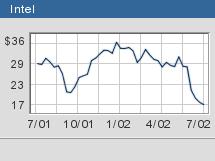
NEW YORK (CNN) -
Intel Corp. Tuesday said it will eliminate roughly 4,000 jobs in the second half of the year after reporting a second-quarter profit that fell short of recently reduced estimates.
Executives of the world's largest chipmaker also provided a cautious outlook for the third quarter and the remainder of the year, as large corporations continue to curtail their information technology spending amid economic uncertainty.
"For the full year of 2002, we continue to expect a second half that is seasonally stronger than the first, but have tempered our expectations for growth," Andy Bryant, Intel's chief financial officer, said on a conference call Tuesday evening.
"Looking back we are comfortable that our business has stabilized and the year-to-year declines we saw in 2001 are behind us," Bryant added. "Looking forward, however, we have yet to see the momentum of the economic recovery in our business. As a result, we will be adjusting our staffing expenses accordingly."
The job reductions represent roughly 4.8 percent of Intel's global work force of 83,000 and follow a job-action that affected some 7,000 employees last year.

The cuts will be made primarily through attrition, voluntary separation programs and targeted reductions in certain business areas, Bryant said. He did not say which specific areas would be affected nor provide specific details on how much cost savings the cuts would achieve.
"I don't think I see any benefits in the immediate quarter," he said.
Shortly after the closing bell Tuesday, Intel reported second-quarter earnings, excluding acquisition-related costs, of $620 million, or 9 cents per share. That's down from $854 million, or 12 cents per share, during the same period last year.
Analysts on average had expected Intel to report a profit of 11 cents per share, according to a survey conducted by First Call. Most company watchers recently lowered their estimates after Intel warned of a shortfall early last month.
Blaming softer-than-expected demand in Europe and a larger-than-expected proportion of revenue from low-end microprocessors, on June 6 Intel lowered the bar for the second quarter, saying it expected second-quarter revenue to be between $6.2 billion and $6.5 billion. The company entered the quarter targeting revenue in a range between $6.4 billion and $7 billion.
At the same time, Intel (INTC: Research, Estimates) said its second-quarter gross margin, the percentage of sales remaining after subtracting product costs, would be 49 percent, "plus or minus a couple of points,"
The company typically does not provide earnings-per-share estimates, choosing instead to set expectations for gross margins.
As it turned out, Intel's second-quarter gross margin was 47 percent, on the low end of its targeted range. But Bryant stressed that Intel's gross margin would have been 48.7 percent without a $106 million charge related to its online services business, which the company decided to fold during the quarter.
Prior to the June 6 warning, the consensus estimate for Intel's second quarter was for a profit of 15 cents per share.
Including acquisition-related costs, Intel's net income for the quarter was $446 million, or 7 cents per share. That compares with net income of $196 million, or 3 cents per share, in the year-ago quarter, which included 9 cents per share in acquisition-related costs.
At $6.3 billion, Intel's second-quarter revenue was essentially flat with the year-ago quarter and in line with the consensus estimate of analysts, according to the First Call survey.
As have most of its counterparts in the IT industry, Intel, the No. 1 supplier of computer microprocessors and flash-memory chips, has been stung by a protracted slump in corporate spending. But it has weathered the downturn better than some.
Advanced Micro Devices (AMD: Research, Estimates), which ranks a distant second to Intel in PC processor and flash-memory sales, lowered it financial targets twice over the past three months, most recently on July 3 when it said its revenue for the second quarter was roughly $600 million. AMD began the quarter expecting to post revenue between $820 million and $900 million.
A bitter price war that has dragged on for years between Intel and AMD also has weighed on each company's bottom line.
Intel president and chief operating officer Paul Otellini said average selling prices, or ASPs, for Intel's computer processors, including those for servers, held steady during the quarter. He said firming prices for processors used in mobile computers and servers helped offset weakness in desktop processor prices.
Overall, ASPs for Intel processors in the second quarter were slightly lower because of deteriorating prices for the processors used in Microsoft's new Xbox video-game console, Otellini said. Microsoft in May slashed the price of the gaming machine to about $200 from $300.
Looking ahead, Intel lowered its gross-margin forecast for 2002. The company said it is now aiming for a gross margin of roughly 51 percent, compared with its prior target of 53 percent.
For the third quarter, Intel said it expects its gross margin to be 51 percent, give or take a couple of points, and its revenue to be in a range between $6.3 billion and $6.9 billion. The most recent consensus estimate was $6.7 billion.
The second half of the year typically is stronger for Intel as sales of PCs and other electronics increase during the back-to-school and holiday seasons. Bryant said the company expects to see "moderate seasonal trends into the second half of the year."
Intel also trimmed its capital spending plan for the year, saying it now expects to spend between $5 billion and $5.2 billion, down from its prior plan to spend $5.5 billion on manufacturing plants and equipment this year.
Spending on research and development in 2002, excluding in-process R&D, is expected to be roughly $4 billion, modestly lower than the previous expectation of $4.1 billion, Intel said.
Shares of Intel rose 26 cents to $18.62 in extended-hours trade after falling nearly 4 percent on Nasdaq ahead of the earnings release.

|

